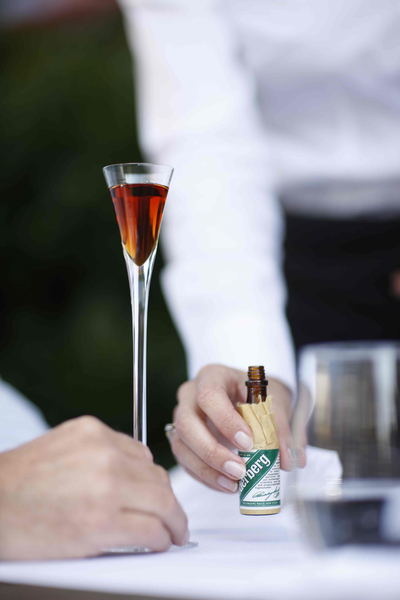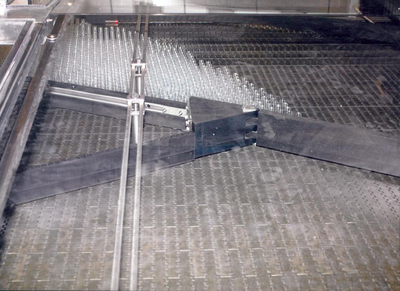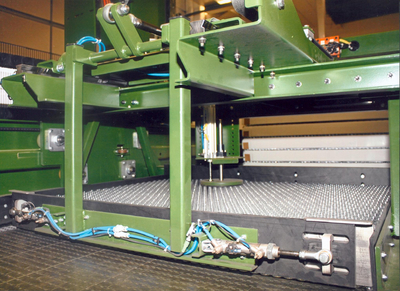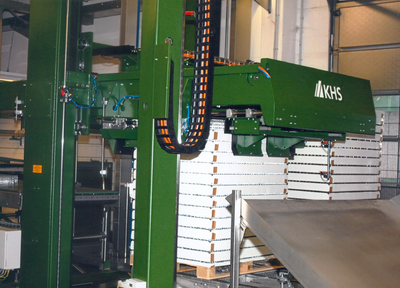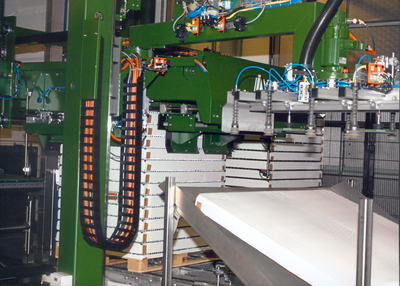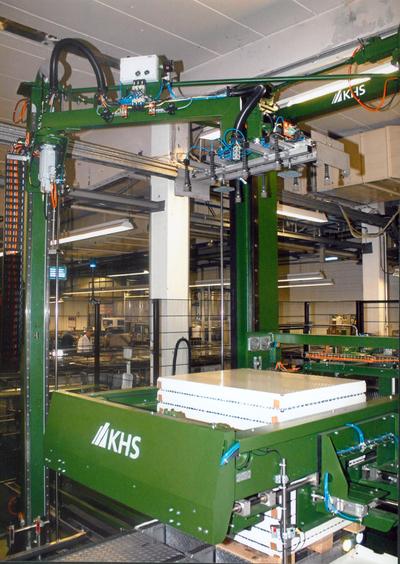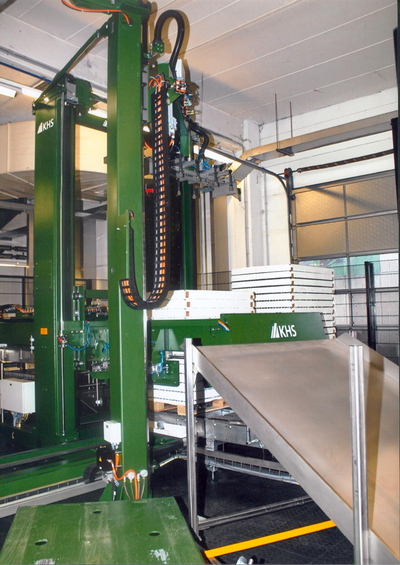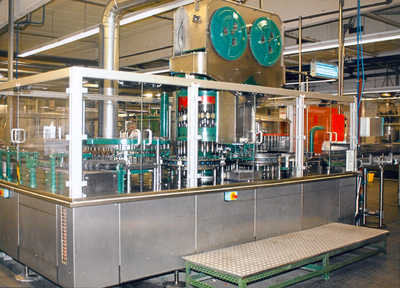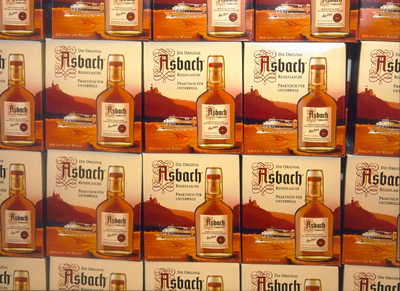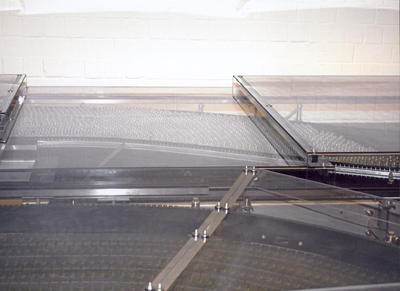
Underberg Group planning on further success – with KHS technology
Underberg-Gruppe plant weitere Erfolge – gemeinsam mit KHS-Technik
Recent investment in a multifunctional, new glass bulk depalletizer Ferdinand Schmitt* Underberg herbal liquor is not only famous the world over; it's also the top-selling single-serving bottle worldwide. Every day millions of people in over 100 countries tear open the straw paper wrapping on the 0.02-liter mini-bottle, thus indulging in the "dose of wellbeing" the herbal digestive is said to provide. Developed in 1846, Underberg is the chief brand of the Underberg Group, who now also sells a number of other products including such resounding names as Asbach, Xuxu, Pitu, Unicum, and Deetling, Riemerschmid fruit and bar syrups, and sparkling wines Schlumberger and Blanc Foussy. All told, the Underberg Group and its approximately 900 employees realize sales of around €500 million annually. It all started with a trip abroad It's said that traveling broadens the mind. This piece of popular wisdom is particularly relevant to the Underberg success story. Taking a closer look, we discover that Underberg essentially owes its existence to the company founder's desire and willingness to travel. During his period of training in the Netherlands, Hubert Underberg tasted a herb elixir that innkeepers used to dilute by guesswork with Genever or Dutch gin. Hubert Underberg valued the herb elixir as a bitter cordial but was irritated by the random addition of Genever so much that he decided to create a beverage which married the soothing properties of the herbs with modern methods of production. * Sales Germany, (Sparkling) Wine, and Spirits Systems, KHS GmbH, Bad Kreuznach. Phone: +49 (671) 852-2515 Recipe a well-guarded family secret No sooner said than done. With Underberg Hubert created a herbal digestive which contains herbs from 43 different countries and which to this very day is manufactured according to Underberg's secret Semper idem process ("With the same effect and quality") which ensures gentle extraction of the active ingredients and aromatic substances from the herbs. The Underberg family makes sure that the recipe is kept a closely guarded secret. In full accordance with the wishes of the company founder, nobody outside the family knows what the recipe is – with the exception of two members of the Catholic clergy sworn to absolute secrecy. Within the Underberg company, only Emil Underberg, his wife Christiane Underberg, and Dr Hubertine Underberg-Ruder know the exact recipe of Underberg in the fourth and fifth generations of the family concern. It is therefore also the family's responsibility to personally select and mix the various herbs to create a harmonious blend. A unique and popular product The fact that Underberg has become and remained extremely popular over the centuries is not just thanks to the beneficial properties and consistent quality of the product but also to a well-chosen marketing concept initiated right from the very start. By the middle of the 19th century company founder Hubert Underberg was placing advertisements in newspapers, handing out pamphlets, and distributing brochures with his product which familiarized customers with the benefits of the herbal beverage. He also designed a stylish, hand-blown Underberg glass which at 24 cm or 10" tall stands heads and shoulders above all the other glasses on the dinner table and is greatly coveted by Underberg fans even now. When the founder's grandson Emil Underberg I developed the 0.02-liter single-serving mini-bottle wrapped in straw paper, the brand became visually unique, advertised in the 1940s on banners pulled behind airships and helicopters, for instance. Slogans, such as "An Underberg a day and you feel good", also proved effective. Targeted expansion It was Emil Underberg II who later pushed ahead with the idea of turning the Underberg Group into an international brand-name spirits company. He not only increased the range of brand products but also the number of production sites. He also ensured that the Underberg firm functions both as a manufacturer and as a commercial enterprise. Foreign production facilities are now located in Austria, Switzerland, Hungary, and France, with German plants situated in Berlin, Erding, and Wilthen. Clear division of labor The production sites in Germany display a clear division of labor; the plant in Erding bottles Riemerschmid fruit and bar syrups, with the production of spirits concentrated on the facilities in Berlin and Wilthen. Berlin is the specialist for miniature bottles, filling from 0.02 to 0.2 liters pro container, where Wilthen deals with the larger receptacles. The production of Underberg in its distinctive 0.02-liter glass bottle is thus quite clearly one of the responsibilities allocated to Berlin. Miniature bottle plant Berlin produces 300 million units a year Production started in Berlin in 1971. When production was increased in 1977 the plant moved to new premises in the Berlin suburb of Heiligensee, where about 300 million miniature bottles containing the Underberg Group's brand-name liquor leave the factory each year. Underberg herbal digestive still holds the biggest share of production. At about the same time as the company moved to Heiligensee its partnership with KHS began when it invested in three KHS filling systems – which at that time managed a very high output of 70,000 miniature bottles an hour. A fourth KHS filler was later added to the 'filler fleet' which even today is still exclusively equipped with KHS systems. KHS filling technology right from the start Edgar Bischoff, manager of the Underberg plant in Berlin, says, "Our KHS filling systems just keep on running and have provided us with very good filling quality right up to the present day. We consider the main reason for such outstanding performance over a period of almost 30 years to be that excellent machine quality and top maintenance and care perfectly complement each other here." Fully automatic new glass bulk depalletizer replaces manual depalletizing Two of the KHS filling systems are used exclusively to fill Underberg's single-serving bottles. The other two KHS fillers deal with the many other products in the Underberg range, filling them into the bottles individually designed for the various markets. Until recently the customary practice for all lines was to receive new glass bottles on new glass pallets loaded with four large trays per layer. In this option, which is now only used on the Underberg herbal digestive lines, operating personnel unpacked the miniature bottles and fed them into the respective lines by hand. The plant has now acquired a fully automatic new glass bulk depalletizer to feed the two multi-product, multi-bottle lines, one of which processes six and the other eight different 0.02-liter miniature bottle types, including those for Asbach, Averna, Hubertus, Boonekamp, Würfelspiel, and Libero spirits. "On deciding to use a fully automatic new glass bulk depalletizer," explains Bischoff, "we were fully aware of the challenges the fully automatic depalletizing of miniature bottles presents. We decided to opt for our trusted partner not only because we find KHS filling technology totally convincing, but because KHS is already giving us excellent performance with the new carton opener recently installed at our plant in Wilthen. In retrospect, we made exactly the right decision there, too." Comprehensive consultancy service KHS began providing consultancy on the proposed investment by initially developing the new glass pallets which were to be depalletized fully automatically. Together with representatives from the Underberg Group and the glassworks a miniature bottle layer pattern was generated for the new glass pallets which, it was assumed, could be perfectly integrated into the production process during ongoing operation. It was also a matter of replacing the inverted tray bases the miniature bottles were packed on to date with inverted trays. "Cooperation with both KHS and the glassworks was very pleasing," notes Bischoff. "However, we attach great importance to having the fully automatic new glass bulk depalletizer developed in theory during round-table discussions live up to its promises in practice." Extremely gentle miniature bottle handling The theory behind the new glass bulk depalletizing process of course entailed much more than simply deciding on a suitable new glass pallet. KHS thus engineered a depalletizing concept that took both the great sensitivity of the miniature bottles and the little space available at the Berlin plant for new glass depalletizing into account. The basic options available for the fully automatic supply of two lines with new glass bottles are to either use two new glass bulk depalletizers, with each one responsible for one line, or to use one depalletizer that services both lines. As space was extremely limited, the Berlin plant chose the single KHS new glass bulk depalletizer option which is highly flexible and also takes the required extremely gentle handling of miniature bottles into full consideration. The shuttle car system The new depalletizing system works in the following manner. Two new glass pallets are placed parallel to one another on the respective segments by a forklift. Each of these pallets contains new glass bottles for one of the two lines to be supplied. If both lines are scheduled to process the same design of miniature bottle, the two parallel new glass pallets are filled with identical glass material. A machine operator removes the film wrapped around the positioned pallets which are then conveyed to a preparation station where they are picked up by a shuttle car with two pallet stations. The supply on the conveyors determines which of the two lines requires more bottles. Based on this information, the shuttle car moves the pallet destined for the line needing supply into the depalletizing area. Equipped with servo technology, the shuttle car not only conveys the pallets extremely gently; it also accurately positions them down to a tenth of a millimeter. Another advantage of this system is that movement is generated exclusively by toothed belts for maintenance-free operation and lower noise levels. Precise adaptation to various situations A handling robot first removes the inverted trays from the pallet placed in depalletizing position by the shuttle car. These trays are then disposed of along an inverted tray chute. A pusher head then travels over and is lowered onto the layer to be depalletized. With the help of torque monitoring, plastic covered plates move with the utmost precision to the layer and grasp it extremely gently. The gripped layers of miniature bottles are then just as carefully pushed onto the bottle table. A sensor system then checks whether all of the miniature bottles are upright once they have been discharged. If not, the machine automatically stops. Choice of line determined by degree of utilization If everything is in order, the miniature bottles travel from the bottle table straight into the line. A light barrier then automatically signals which line is to be supplied with bottles in the next stage of the process. If both lines are equally well supplied, priority is always given to the bottling line with the higher capacity. If, for example, Line Two is to be supplied with a new layer of miniature bottles after Line One, the shuttle car has to change the position of the pallets; after the miniature bottles have been placed on Line One and the system has signaled that the table area is completely empty, the distributor switch on the bottle table then also has to change position. Incidentally, like the shuttle car the bulk depalletizer also makes use of servo technology and thus works with the utmost position accuracy. Here, too, toothed belts ensure that operation is quiet and maintenance negligible. After all bottles have been removed from the pallet, the handling robot transports the empty pallets to a specially designated parking station. In the slot now available the shuttle car is supplied with the next pallet of new glass bottles destined for the product to be processed. Meeting the highest hygienic demands The glass bottles fed into the lines are passed on to the filling system by specially designed mat top chains. These mat top chains not only ensure trouble-free conveying; they also do not require any lubrication. This has benefits regarding both hygiene and cost. Covering the conveyor tunnels with Makrolon covers that can be easily opened as and when required is yet another aspect that meets the highest hygienic demands. Top results Bischoff is extremely satisfied with KHS' new glass bulk depalletizing concept. "KHS has carried out everything to our complete satisfaction. Despite the fact that we're depalletizing extremely sensitive miniature bottles, we have recorded less than 10 downers per shift – with over 200,000 bottles processed. Instead of working with three to four operators as in the past, we now only have one operator in new glass bulk depalletizing area. I call this top results." Prepared for the future Bischoff also finds it tops that the new glass bulk depalletizer is well prepared for all future eventualities. It can be connected up to new lines and – if required – it can also process other sizes of miniature bottle alongside the 0.02-liter style. "Anything is possible with this system – and has to be, considering that we plan very far ahead with our machines," says Bischoff. He believes that the new glass bulk depalletizer has just as much chance of as long a service life as the KHS filling systems. He claims, "Top quality is standard for KHS technology. We are thus reckoning with a lengthy period of use." The plant in Berlin not only places great emphasis on top quality but also on the maximum flexibility of their technical systems. This is especially understandable considering that the company is expecting increased demand both at home and abroad in the next few years. This is expected to apply to the classic Underberg in particular. Countless advertising campaigns, many of which have cult status, are backing this up, such as the series of decorative, metal Underberg boxes which each year have taken consumers on a culinary journey to Asia, Italy, Greece, Germany, Spain, and South Africa – and most recently to Austria. There's also the Tops & More loyalty system, where consumers who carefully collect Underberg caps are promised interesting rewards, et cetera, et cetera, et cetera. This once again shows that over the centuries Underberg has remained true to a code which has proved successful. Bischoff explains, "Here, high-quality appearance and attractive marketing campaigns are geared towards the high quality of the product. Here, tradition meets innovation. Here, the success story shall continue." Together with KHS.
